Stars, Story, Facts, Location – Constellation Guide (original) (raw)
Musca constellation is located in the southern sky, just to the south of Crux, the Southern Cross. Its name means “the fly” in Latin.
The constellation was created by the Dutch astronomer Petrus Plancius from the observations of Dutch navigators Pieter Dirkszoon Keyser and Frederick de Houtman in the late 16th century. It was first depicted in a celestial atlas in 1603, in Johann Bayer’s Uranometria.
Musca has several notable stars and deep sky objects, among them Nova Muscae 1991, the binary system with a black hole, the Spiral Planetary Nebula (NGC 5189), the Hourglass Nebula (MyCn 18), the globular clusters NGC 4833 and NGC 4372 and the Dark Doodad Nebula.
Facts, location and map
Musca is the 77th constellation in size, occupying an area of 138 square degrees. It is located in the third quadrant of the southern hemisphere (SQ3) and can be seen at latitudes between +10° and -90°. The neighboring constellations are Apus, Carina, Centaurus, Chamaeleon, Circinus and Crux.
The constellation name Musca is pronounced /ˈmʌskə/. In English, the constellation is known as the Fly. The genitive form of Musca, used in star names, is Muscae (pronunciation: /ˈmʌsiː/). The three-letter abbreviation, adopted by the International Astronomical Union (IAU) in 1922, is Mus.
Musca belongs to the Johann Bayer family of constellations, along with Apus, Chamaeleon, Dorado, Grus, Hydrus, Indus, Pavo, Phoenix, Tucana and Volans.
Musca contains one star with known planets and has no Messier objects. The brightest star in the constellation is Alpha Muscae, with an apparent magnitude of 2.69. There are no meteor showers associated with the constellation.
Musca does not contain any formally named stars.
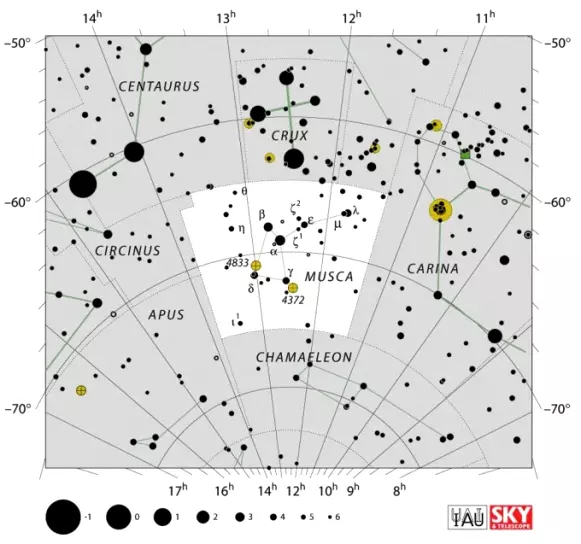
Musca constellation map by IAU and Sky&Telescope magazine
Musca was one of the 12 constellations introduced by the Dutch navigators Keyser and de Houtman during their expeditions to the East Indies in the late 16th century. In de Houtman’s catalogue of 1603, the constellation is called De Vlieghe, which is Dutch for “the fly.”
The Dutch cartographer Petrus Plancius was the first to include the constellation on his globe of 1598, but left it unnamed. When Johann Bayer included it is his star atlas Uranometria, he called the constellation Apis, the Bee, and this name was widely used for about two centuries.
The constellation first appeared under the name Musca in 1602, on a globe by the Dutch cartographer Willem Janszoon Blaeu. Plancius did not use any names for the constellation until 1612, when he named it Muia on his globe, which is Greek for “the fly.”
For a while, the constellation was known as the Southern Fly, Musca Australis, as there was a constellation called Musca Borealis, the Northern Fly, at the time, located in the north of what is today Aries constellation. The French astronomer Nicolas Louis de Lacaille was the one who named the constellation Musca Australis. The name was later shortened to simply Musca.
Musca stars
α Muscae (Alpha Muscae)
Alpha Muscae is a blue-white star halfway between the dwarf and subgiant evolutionary stages. It has the stellar classification of B2 IV-V. The star has an apparent magnitude of 2.69 and is approximately 315 light years distant from the Sun. It is the brightest star in Musca constellation.
Alpha Muscae has 8.8 times the Sun’s mass and 4.8 times the solar radius. It is 4,000 times more luminous than the Sun. It is a pretty fast rotator, with a projected rotational velocity of 114 km/s. The star is classified as a Beta Cephei type variable, which means that it exhibits variations in brightness as a result of pulsations of its surface.
β Muscae (Beta Muscae)
Beta Muscae is a binary star system composed of two stars separated by 1.206 arc seconds. It has a combined apparent magnitude of 3.05 and is approximately 340 light years distant from the Sun. The stars have an orbital period of about 194 years.
Both stars in the system are blue-white main sequence dwarfs. They belong to spectral classes B2 V and B3 V. Beta Muscae A has an apparent magnitude of 3.51 and Beta Muscae B has a magnitude of 4.01. The stars are similar in size and appearance. The primary component has 7.35 solar masses and the companion has 6.40 times the Sun’s mass.
Beta Muscae is a member of the Scorpius-Centaurus association of stars with similar ages, trajectories and locations, which likely formed together in the same molecular cloud. It is also a confirmed runaway star system, one moving through space with an abnormally high velocity compared to the surrounding interstellar medium.
δ Muscae (Delta Muscae)
Delta Muscae is a spectroscopic binary star system with an apparent magnitude of 3.61. At a distance of 91 light years, it is the nearest star system to Earth in Musca constellation. Based on the information in the Gliese Catalogue of Nearby Stars, there are about 3,800 stars that are closer to Earth than Delta Muscae.
The primary star is an orange giant with the stellar classification of K2III, and the spectral type of the companion star is unknown.
λ Muscae (Lambda Muscae)
Lambda Muscae is a star in a dual system. It belongs to the stellar class A7III, which means that it is a white giant star, significantly hotter than our Sun. It is the farthest right star in the constellation and marks the fly’s tail.
Lambda Muscae has an apparent magnitude of 3.68 and is the fourth brightest star in Musca constellation. It is about 128 light years distant from Earth.
γ Muscae (Gamma Muscae)
Gamma Muscae is a blue-white main sequence dwarf. It has an apparent magnitude of 3.84 and can be seen without binoculars. The star has the stellar classification of B5V and is approximately 325 light years distant from the solar system. It is 790 times more luminous than the Sun.
ε Muscae (Epsilon Muscae)
Epsilon Muscae is a red giant star belonging to the stellar class M5III. It has an apparent magnitude of 4.11 and is approximately 302 light years distant.
μ Muscae (Mu Muscae)
Mu Muscae is an orange giant with the stellar classification of K4III. It has an apparent magnitude of 4.75 and is about 432 light years distant from the solar system.
HD 115211
HD 115211 is an orange supergiant star with the stellar classification of K2Ib-II. It has an apparent magnitude of 4.87 and is approximately 1,185 light years distant from the Sun.
HD 103079
HD 103079 is a binary star with a combined stellar classification of B4V, matching the spectrum of a blue-white main sequence dwarf. It has a visual magnitude of 4.93 and is approximately 338 light years distant from Earth.
HD 102839
HD 102839 has an apparent magnitude of 4.98 and an absolute magnitude of -3.27. It is a yellow supergiant star with the stellar classification of G5Ib. The star is approximately 1,455 light years distant from the solar system.
λ Chamaeleontis (Lambda Chamaeleontis)
Lambda Chamaeleontis, also known as HD 105340 and HR 4617, is an orange giant star with the stellar classification K2III. It has an apparent magnitude of 5.18 and is 437.3 light years distant from Earth. It has twice the mass of the Sun.
Lacaille designated the star Lambda Chamaeleontis in his Coelum Australe Stelliferum, but when the constellation borders were redefined in 1930, the star was placed in Musca rather than Chamaeleon constellation.
HD 111232
HD 111232 is a yellow main sequence dwarf belonging to the stellar class G8V. It has a visual magnitude of 7.61 and is 95 light years distant from the solar system. The star has 78 percent of the Sun’s mass.
A planet with at least 6.80 times the mass of Jupiter is orbiting the star with a period of 1,143 days.
Nova Muscae 1991 (GU Muscae, GRS 1124-683)
Nova Muscae 1991 is a binary system containing a black hole candidate. It is one of the few black hole systems classified as X-ray novae, ones that occasionally produce outbursts of X-rays along with visible light and other forms of energy. The two stars orbit each other with a period of 10.4 hours and are approximately 3.2 million kilometres apart.
In a system like this one, the black hole pulls gas from the companion star’s surface, and the gas forms an accretion disk around the black hole. In the case of an X-ray nova, the flow of gas is quite slow and thin, and the disk around the black hole stays relatively cool. Some of the gas also falls into the black hole.
The black hole in Nova Muscae 1991 has seven times the Sun’s mass, while the companion star has three-quarters of the Sun’s mass and one third of the Sun’s luminosity. The star’s outer layers were likely blown off by the supernova that produced the black hole.
Deep sky objects in Musca
Spiral Planetary Nebula – NGC 5189 (Gum 47, IC 4274)
NGC 5189 is a planetary nebula in Musca. It has an apparent magnitude of 8.2 and is approximately 3,000 light years distant. It was discovered by the Scottish astronomer James Dunlop in July 1826.
In a telescope, the nebula appears S-shaped, similar to a barred spiral galaxy, which is how it got the name Spiral Planetary Nebula.
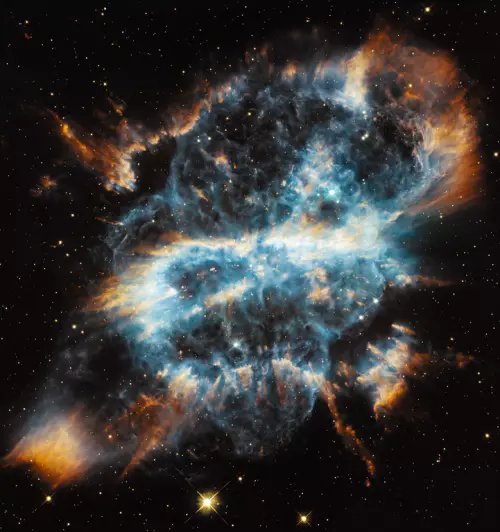
Spiral Planetary Nebula (NGC 5189), image: NASA, ESA and the Hubble Heritage Team (STScI/AURA)
NGC 4372
NGC 4372 is a globular cluster in Musca. It has an apparent magnitude of 7.8 and is approximately 18,900 light years distant from Earth.
Hourglass Nebula (MyCn 18)
The Engraved Hourglass Nebula is another planetary nebula in Musca constellation. It has an apparent magnitude of 13 and is approximately 8,000 light years distant from Earth.
The nebula was discovered by Annie Jump Cannon and Margaret W. Mayall in the early 20th century, while they were working on an extended Henry Draper Catalogue.
The nebula is not to be confused with the less famous Hourglass Nebula which is located inside the Lagoon Nebula (Messier 8) in Sagittarius.
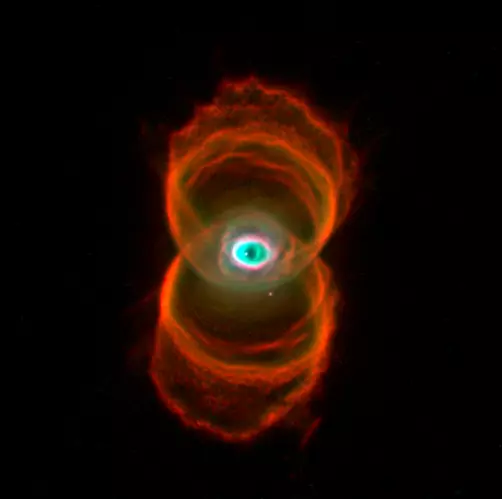
The Engraved Hourglass Nebula (MyCn18) is a young planetary nebula located about 8,000 light years away. This artificially colorized image was taken with the Wide Field and Planetary Camera 2 aboard NASA’s Hubble Space Telescope. Image: NASA, R. Sahai, J. Trauger (JPL), and The WFPC2 Science Team
NGC 4833
NGC 4833 is a globular cluster in Musca. It has an apparent magnitude of 7.79 and is approximately 21,200 light years distant from the solar system.
The cluster was discovered by Nicolas Louis de Lacaille in 1751-1752. It is partially obscured by dust of the galactic plane. The cluster is 42 light years in radius.
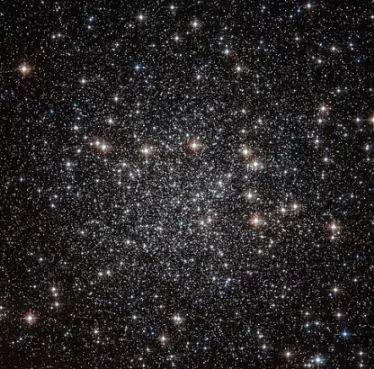
Located approximately 22,000 light-years away in the constellation of Musca (The Fly), this tightly packed collection of stars — known as a globular cluster — goes by the name of NGC 4833. This NASA/ESA Hubble Space Telescope image shows the dazzling stellar group in all its glory. NGC 4833 is one of the over 150 globular clusters known to reside within the Milky Way. These objects are thought to contain some of the oldest stars in our galaxy. Studying these ancient cosmic clusters can help astronomers to unravel how a galaxy formed and evolved, and give an idea of the galaxy’s age. Globular clusters are responsible for some of the most striking sights in the cosmos, with hundreds of thousands of stars congregating in the same region of space. Hubble has observed many of these clusters during its time in orbit around our planet, each as breathtaking as the last. Image: ESA/Hubble and NASA
Dark Doodad Nebula
The Dark Doodad Nebula is located next to the globular cluster NGC 4372, and just south of the famous Coalsack Nebula in the constellation Crux. It is a dark nebula which is part of the Musca molecular cloud. It spans about 3 degrees in the sky and can be seen with strong binoculars.
The nebula was named the Dark Doodad by the American author, amateur astronomer and astro-imager Dennis di Cicco in 1986, who observed it from central Australia. It is more than 30 light years across and lies approximately 700 light years from Earth.
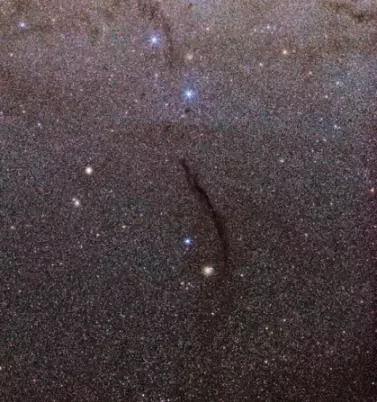
The Dark Doodad Nebula, with globular cluster NGC 4372 at its southern end. Image: Wikimedia Commons/Naskies (CC BY-SA 3.0)